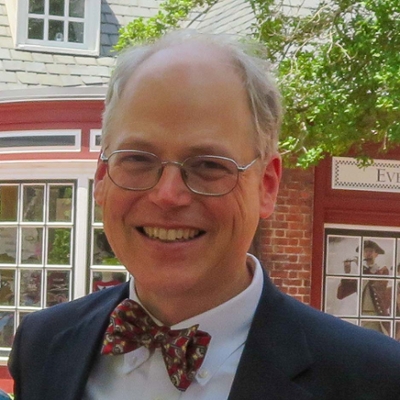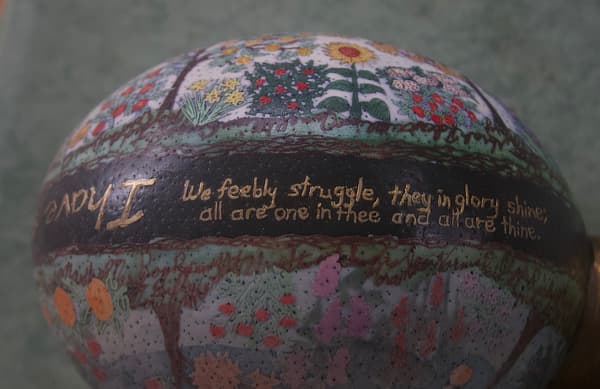
For over a thousand years, many Christians have celebrated November 1 as All Saints’ Day. In America, the day is best known for the preceding day: All Hallows’ Eve or Halloween. On Halloween we try to scare each other and dress up as what we are not. On All Saints’ Day, we encourage each other by remembering who we are.
For the past several decades, many churches have observed All Saints’ Day on the following Sunday. This year November 1 falls on a Sunday so everyone will celebrate together.
Like any holiday, All Saints’ Day means various things to various people. Holidays are like that. They carry many meanings. As I see it, All Saints’ Day has three themes: (1) the union of all Christians, living and dead, in one organism, the body of Christ, (2) the inspiring example of other Christians, especially those who have died, and (3) remembering those who are no longer physically with us.
For me, there are two essentials for worship on All Saints’: the collect (or opening prayer) for All Saints’ Day and singing six or more stanzas (to Ralph Vaughn Williams’s tune) of William How’s hymn “For All the Saints.” Other hymns and prayers might work just as well, but I’m among the many who prize these. In the collect we offer God the whole sentiment of the day. In the hymn we praise Christ for those who have gone before us. Through song we participate with them in that “more glorious day” when Christ leads his people through “gates of pearl” into his eternal city (Revelation 21:21).
The collect draws abundantly from scripture in voicing the day’s three themes:
Almighty God, you have knit together your elect in one communion and fellowship in the mystical body of your Son Christ our Lord: Give us grace so to follow your blessed saints in all virtuous and godly living, that we may come to those ineffable joys that you have prepared for those who truly love you; through Jesus Christ our Lord, who with you and the Holy Spirit lives and reigns, one God, in glory everlasting. Amen.
All three themes voiced in the prayer are important. Accenting each of them in one service is difficult, but it is ideal.
The communities with whom I worship are most eager to remember our loved ones and anticipate joining them in heaven. We are not as good at keeping the other two themes in view. In the Roman Catholic tradition, November 1 is the Solemnity of All Saints. God is praised for his glory displayed in the grace-filled lives of those in heaven. The following day is the Commemoration of All the Faithful Departed, or All Souls’ Day. It has a more somber tone as Christians remember and pray for their departed loved ones that they come to enjoy full glory. Since Protestants do not anticipate a journey through purgatory after death, we remember our beloved dead on All Saints’ Day. But when we do, we sometimes reduce All Saints’ Day to All Souls’ Day. We must also remember the example of the saints and our mystical union in Christ.
 Remembering, grieving, and celebrating our dead family and friends is honest work. It is also important to affirm the hope they had in Christ’s resurrection. After my father died, my wife, participated in an Easter devotional art show at church entitled “Stations of the Resurrection.” Martha dyes eggs in the Ukrainian tradition known as pysanky. Her “station” was an ostrich egg in memory of my father. It features a line from How’s hymn “we feebly struggle, they in glory shine” and depicts two gardens, one distressed on earth another radiant in heaven. The names of departed family members form the entwined roots of the trees in the radiant garden. For us, this is an important symbol of what we celebrate on All Saints’. We remember the dead, rejoicing in their glory, but also celebrate the union of all of us in the one body of Christ, here represented by the one egg. As the hymn’s stanza on the egg concludes, “yet all are one in thee, for all are thine.”
Remembering, grieving, and celebrating our dead family and friends is honest work. It is also important to affirm the hope they had in Christ’s resurrection. After my father died, my wife, participated in an Easter devotional art show at church entitled “Stations of the Resurrection.” Martha dyes eggs in the Ukrainian tradition known as pysanky. Her “station” was an ostrich egg in memory of my father. It features a line from How’s hymn “we feebly struggle, they in glory shine” and depicts two gardens, one distressed on earth another radiant in heaven. The names of departed family members form the entwined roots of the trees in the radiant garden. For us, this is an important symbol of what we celebrate on All Saints’. We remember the dead, rejoicing in their glory, but also celebrate the union of all of us in the one body of Christ, here represented by the one egg. As the hymn’s stanza on the egg concludes, “yet all are one in thee, for all are thine.”
All Saints’ is also about following the example of the faithful departed. On the egg, the names of living family members form roots of those who are still working on following the example of the saints in the imperfect garden. In worship on All Saints’ the “Beatitudes” (Matthew 5:1-12) are often read. They offer one of Jesus’ summaries of Christian virtues. We remember how Christians, by God’s grace, are able to display these virtues. Whatever the saints’ stories, as Fred Pratt Green’s hymn, “Rejoice in God’s Saints,” concludes, “In loving, in giving, they prove it is true: the way of self-giving, Lord, leads us to you.” On All Saints’ we need to be exhorted to follow these saints in such virtuous and godly living.
We also need to be assured, as martyred theologian—and saint—Dietrich Bonhoeffer wrote in Cost of Discipleship, that these virtues are what we are and can be because of Christ’s work in us. Saintliness is a gift given to all Christians more than it is an achievement.
This brings us to the most important of the three themes of All Saints’: all Christians are knit together in the one body of Christ. Many years ago, on All Saints’ Day, I heard an old monk preach. He was a knitter, and his sermon focused on that phrase in the collect from Colossians 2:2: “knit together.” He said that, the church, Christ’s people, the body of Christ, was like an old rug. We are carefully knotted together into one. Many strands, many colors, warts and all, redeemed in Christ. My wife knits with a group from church every Thursday. The group talks while they knit. Sometimes the talk goes smoothly, other times it does not. But they keep knitting and keep talking because they know that they are the body of Christ for the world.
Saint Augustine, the fourth-century North African pastor, taught Christians receiving the bread of the Lord’s supper as the body of Christ to “Be what you see, and receive what you are” (Sermon 272). All Saints’ reminds us that all of us are members of the body of Christ, joined together in joys and sorrows. Furthermore, we are the body of Christ for the world. Some theologians drive this point home by speaking of the church not merely the body of Christ, but the continuation of the incarnation.
Nowhere is this more clearly manifested than when we come together as one to worship in whatever way they can, in person, on Zoom, through webcasts. Whether in singing, prayer, being shaped by the word preached, or celebrating the Lord’s supper, we participate as one body in Christ. Through worship we are called to “carry each other’s burdens” (Galatians 6:2). Knowing, as one of the twentieth century’s first advocates of worship renewal wrote, that “all our good actions and merits likewise, which we perform only through Christ, belong strictly to Christ for attaining the purpose of Christ.” (Virgil Michel, “Liturgy: The Basis of Social Regeneration,” 1935).
All Saints’ Day is a day when we remember that we are by God’s grace one body in Christ Jesus, united with Christians around the world and in heaven in praising and serving God. Christ is present through Christians for the world and to be a Christian is not an individual occupation. It is not even a congregational, denominational, or national occupation. It is to be subsumed into a larger whole that is one with Christ Jesus seeking the welfare of all. For me that is the essence of All Saints’ Day.
David R. Bains has taught Samford undergraduate religion courses since 1999. Among his favorite courses is “Christian Worship: History and Theology” which he introduced into the curriculum in 2001. His publications include “Beliefs and Practices” in The Future of Mainline Protestantism in America (Columbia University Press).
